MAZDA MODEL CX-9 2008 (in English) Owner's Manual
Manufacturer: MAZDA, Model Year: 2008, Model line: MODEL CX-9, Model: MAZDA MODEL CX-9 2008Pages: 506, PDF Size: 11.52 MB
Page 21 of 506
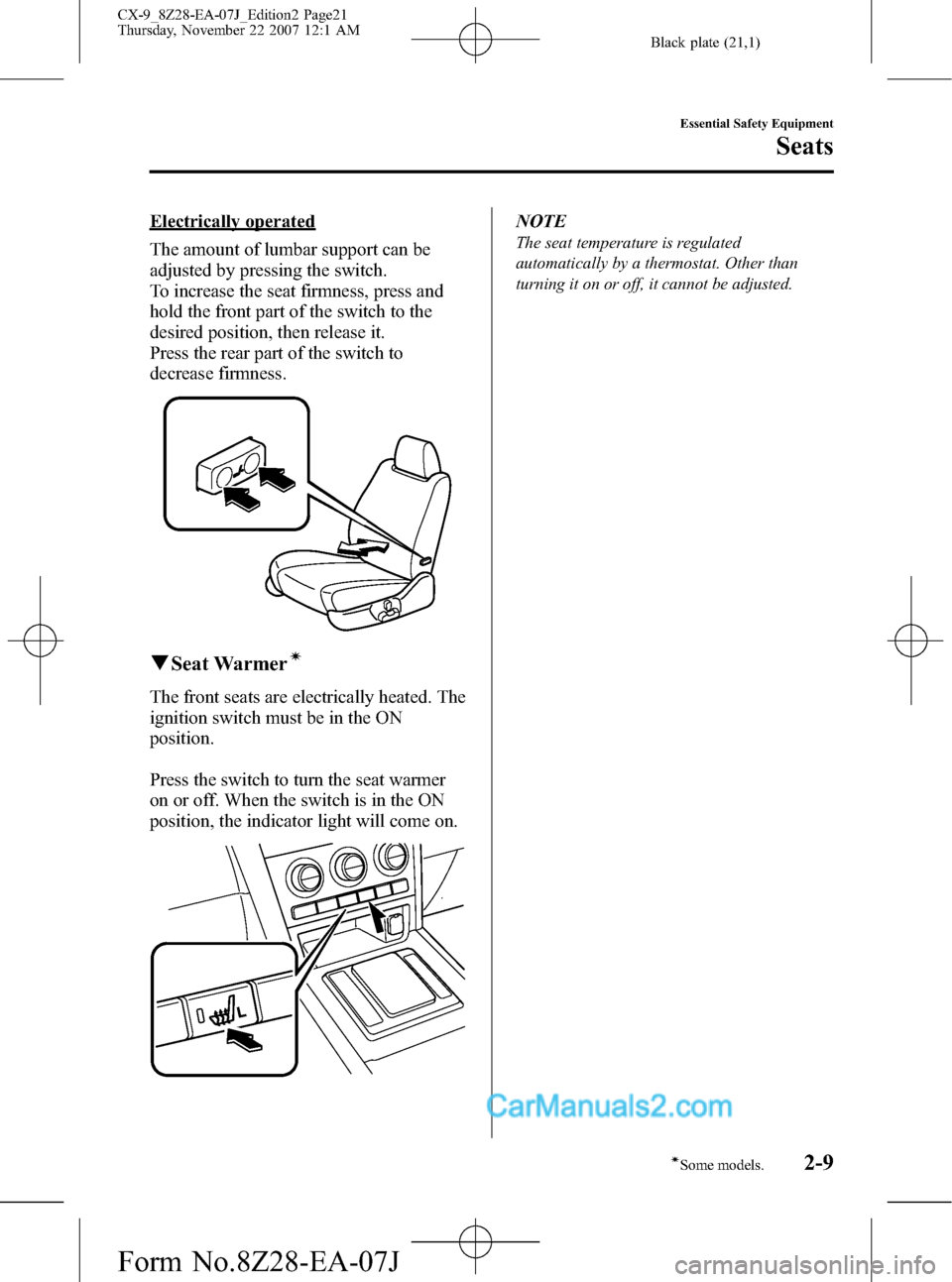
Black plate (21,1)
Electrically operated
The amount of lumbar support can be
adjusted by pressing the switch.
To increase the seat firmness, press and
hold the front part of the switch to the
desired position, then release it.
Press the rear part of the switch to
decrease firmness.
qSeat Warmerí
The front seats are electrically heated. The
ignition switch must be in the ON
position.
Press the switch to turn the seat warmer
on or off. When the switch is in the ON
position, the indicator light will come on.
NOTE
The seat temperature is regulated
automatically by a thermostat. Other than
turning it on or off, it cannot be adjusted.
Essential Safety Equipment
Seats
2-9íSome models. CX-9_8Z28-EA-07J_Edition2 Page21
Thursday, November 22 2007 12:1 AM
Form No.8Z28-EA-07J
Page 22 of 506
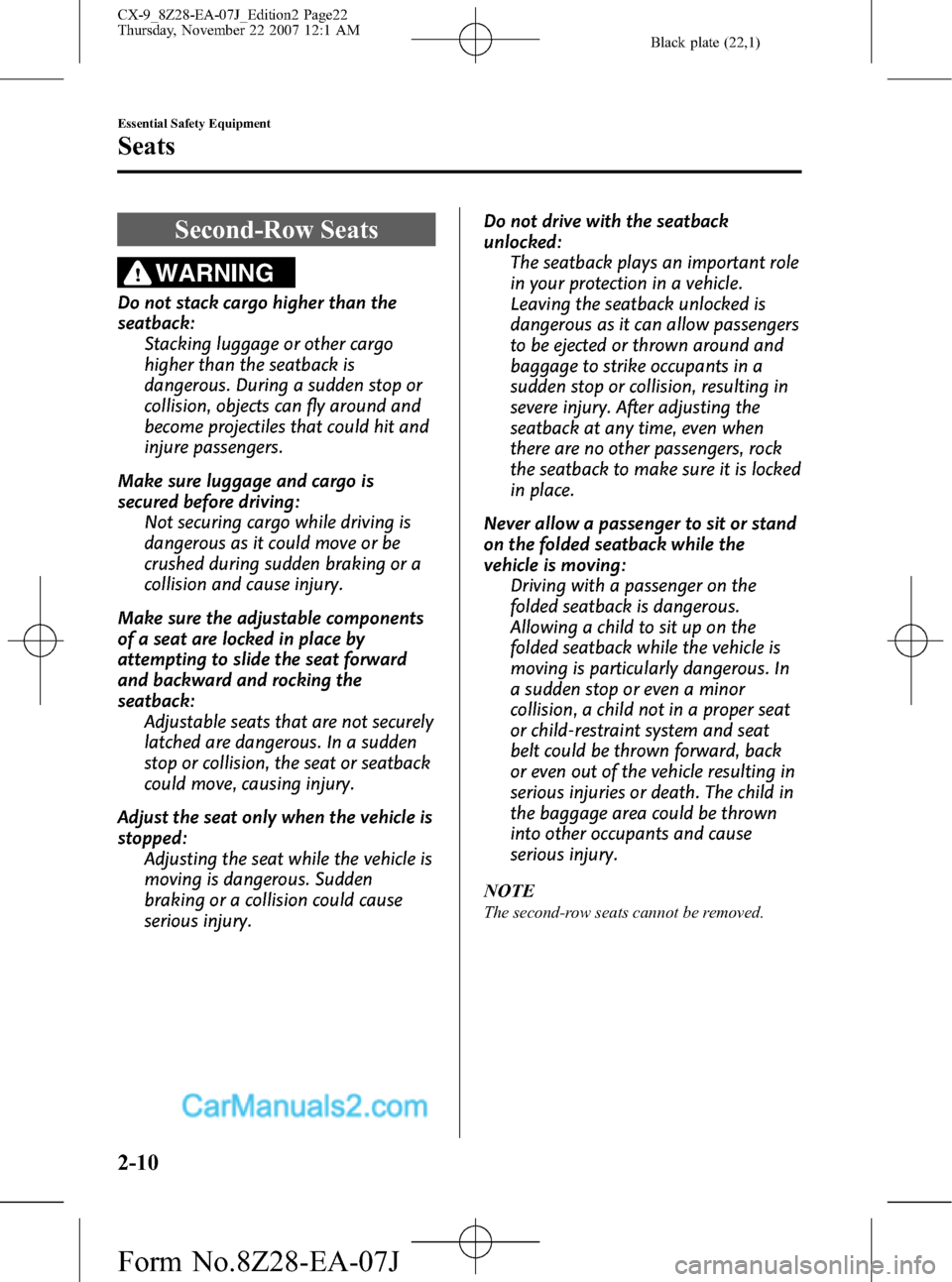
Black plate (22,1)
Second-Row Seats
WARNING
Do not stack cargo higher than the
seatback:
Stacking luggage or other cargo
higher than the seatback is
dangerous. During a sudden stop or
collision, objects can fly around and
become projectiles that could hit and
injure passengers.
Make sure luggage and cargo is
secured before driving:
Not securing cargo while driving is
dangerous as it could move or be
crushed during sudden braking or a
collision and cause injury.
Make sure the adjustable components
of a seat are locked in place by
attempting to slide the seat forward
and backward and rocking the
seatback:
Adjustable seats that are not securely
latched are dangerous. In a sudden
stop or collision, the seat or seatback
could move, causing injury.
Adjust the seat only when the vehicle is
stopped:
Adjusting the seat while the vehicle is
moving is dangerous. Sudden
braking or a collision could cause
serious injury.Do not drive with the seatback
unlocked:
The seatback plays an important role
in your protection in a vehicle.
Leaving the seatback unlocked is
dangerous as it can allow passengers
to be ejected or thrown around and
baggage to strike occupants in a
sudden stop or collision, resulting in
severe injury. After adjusting the
seatback at any time, even when
there are no other passengers, rock
the seatback to make sure it is locked
in place.
Never allow a passenger to sit or stand
on the folded seatback while the
vehicle is moving:
Driving with a passenger on the
folded seatback is dangerous.
Allowing a child to sit up on the
folded seatback while the vehicle is
moving is particularly dangerous. In
a sudden stop or even a minor
collision, a child not in a proper seat
or child-restraint system and seat
belt could be thrown forward, back
or even out of the vehicle resulting in
serious injuries or death. The child in
the baggage area could be thrown
into other occupants and cause
serious injury.
NOTE
The second-row seats cannot be removed.
2-10
Essential Safety Equipment
Seats
CX-9_8Z28-EA-07J_Edition2 Page22
Thursday, November 22 2007 12:1 AM
Form No.8Z28-EA-07J
Page 23 of 506
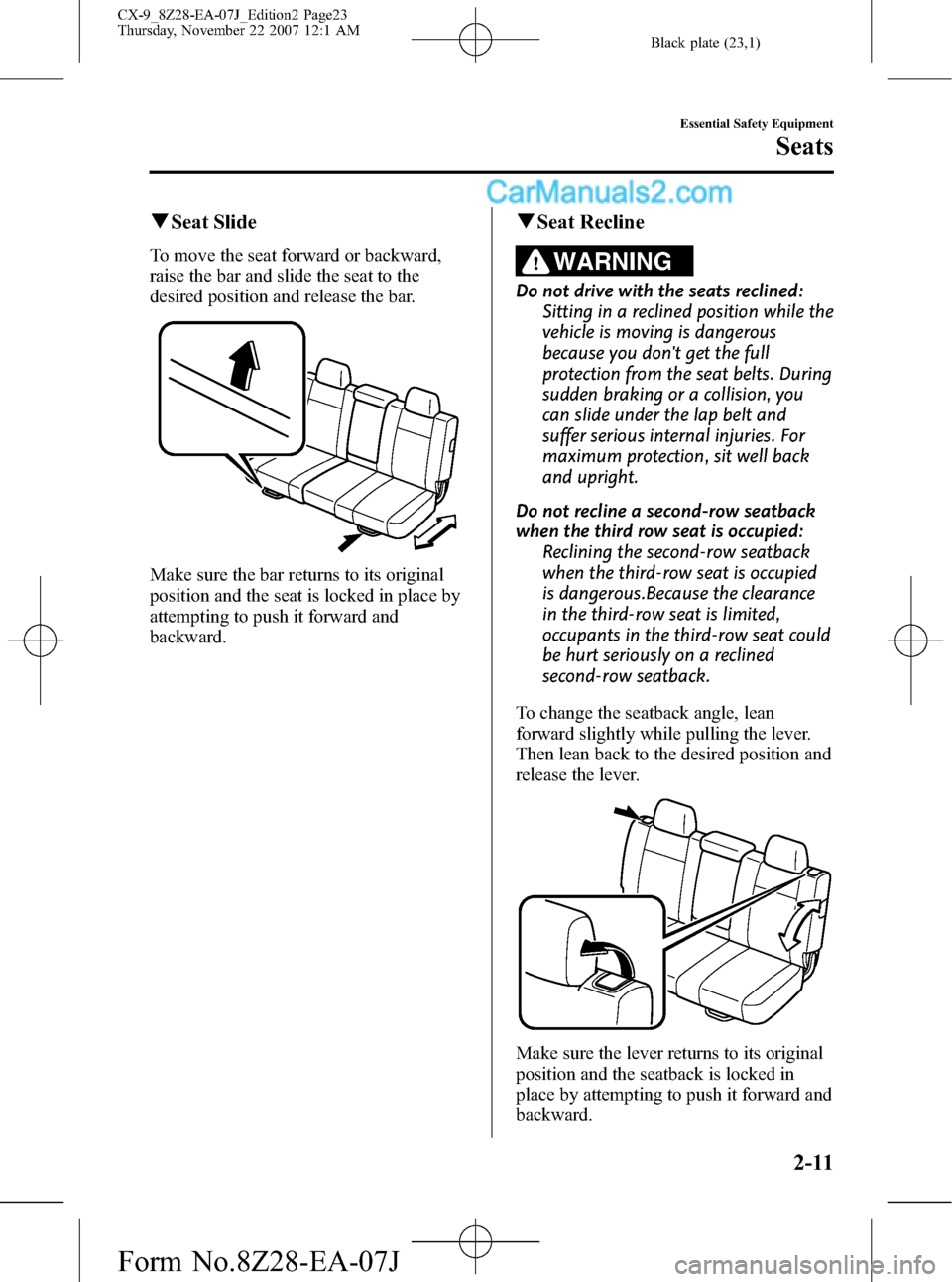
Black plate (23,1)
qSeat Slide
To move the seat forward or backward,
raise the bar and slide the seat to the
desired position and release the bar.
Make sure the bar returns to its original
position and the seat is locked in place by
attempting to push it forward and
backward.
qSeat Recline
WARNING
Do not drive with the seats reclined:
Sitting in a reclined position while the
vehicle is moving is dangerous
because you don't get the full
protection from the seat belts. During
sudden braking or a collision, you
can slide under the lap belt and
suffer serious internal injuries. For
maximum protection, sit well back
and upright.
Do not recline a second-row seatback
when the third row seat is occupied:
Reclining the second-row seatback
when the third-row seat is occupied
is dangerous.Because the clearance
in the third-row seat is limited,
occupants in the third-row seat could
be hurt seriously on a reclined
second-row seatback.
To change the seatback angle, lean
forward slightly while pulling the lever.
Then lean back to the desired position and
release the lever.
Make sure the lever returns to its original
position and the seatback is locked in
place by attempting to push it forward and
backward.
Essential Safety Equipment
Seats
2-11
CX-9_8Z28-EA-07J_Edition2 Page23
Thursday, November 22 2007 12:1 AM
Form No.8Z28-EA-07J
Page 24 of 506
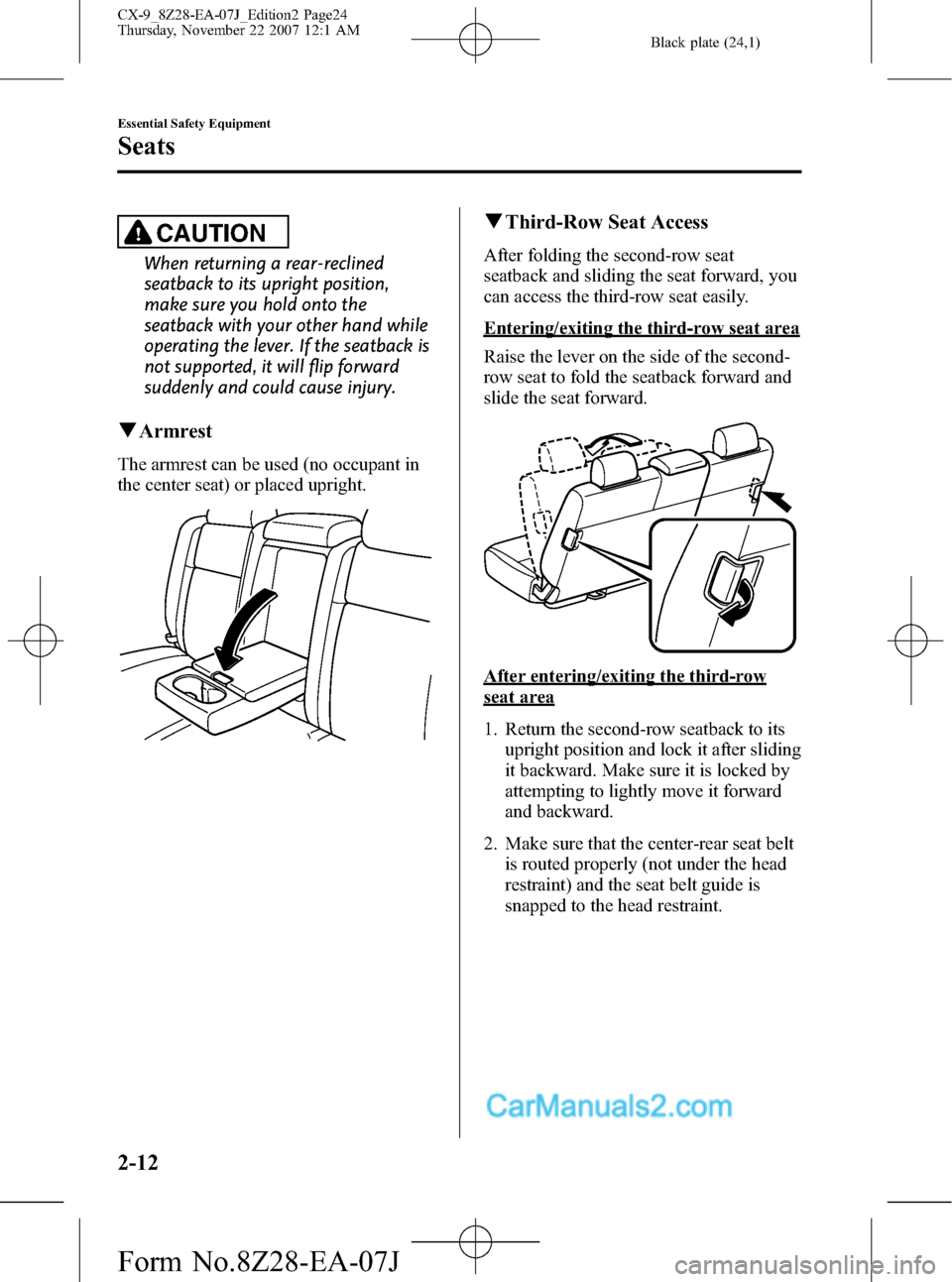
Black plate (24,1)
CAUTION
When returning a rear-reclined
seatback to its upright position,
make sure you hold onto the
seatback with your other hand while
operating the lever. If the seatback is
not supported, it will flip forward
suddenly and could cause injury.
qArmrest
The armrest can be used (no occupant in
the center seat) or placed upright.
qThird-Row Seat Access
After folding the second-row seat
seatback and sliding the seat forward, you
can access the third-row seat easily.
Entering/exiting the third-row seat area
Raise the lever on the side of the second-
row seat to fold the seatback forward and
slide the seat forward.
After entering/exiting the third-row
seat area
1. Return the second-row seatback to its
upright position and lock it after sliding
it backward. Make sure it is locked by
attempting to lightly move it forward
and backward.
2. Make sure that the center-rear seat belt
is routed properly (not under the head
restraint) and the seat belt guide is
snapped to the head restraint.
2-12
Essential Safety Equipment
Seats
CX-9_8Z28-EA-07J_Edition2 Page24
Thursday, November 22 2007 12:1 AM
Form No.8Z28-EA-07J
Page 25 of 506
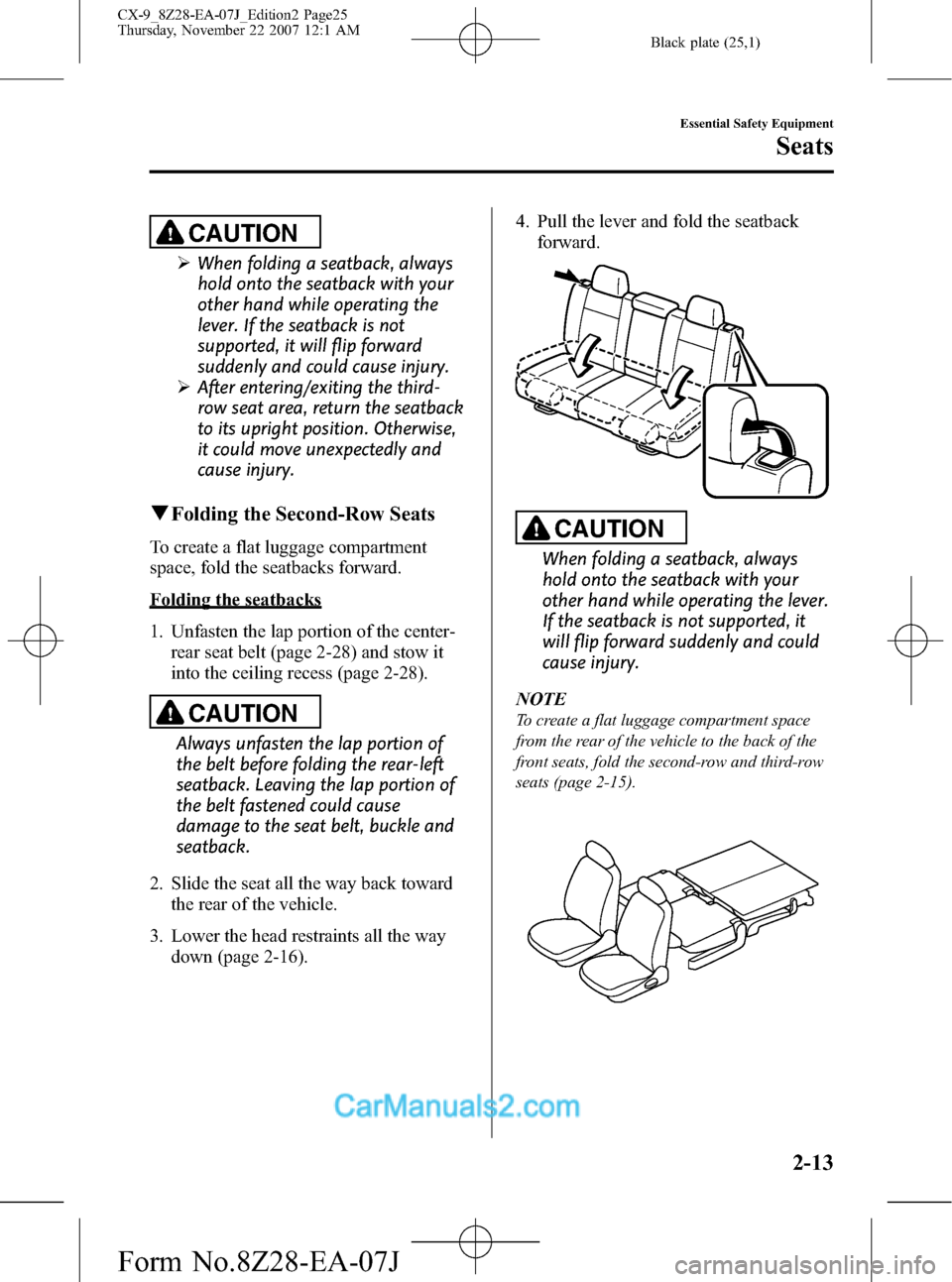
Black plate (25,1)
CAUTION
ØWhen folding a seatback, always
hold onto the seatback with your
other hand while operating the
lever. If the seatback is not
supported, it will flip forward
suddenly and could cause injury.
ØAfter entering/exiting the third-
row seat area, return the seatback
to its upright position. Otherwise,
it could move unexpectedly and
cause injury.
qFolding the Second-Row Seats
To create a flat luggage compartment
space, fold the seatbacks forward.
Folding the seatbacks
1. Unfasten the lap portion of the center-
rear seat belt (page 2-28) and stow it
into the ceiling recess (page 2-28).
CAUTION
Always unfasten the lap portion of
the belt before folding the rear-left
seatback. Leaving the lap portion of
the belt fastened could cause
damage to the seat belt, buckle and
seatback.
2. Slide the seat all the way back toward
the rear of the vehicle.
3. Lower the head restraints all the way
down (page 2-16).4. Pull the lever and fold the seatback
forward.
CAUTION
When folding a seatback, always
hold onto the seatback with your
other hand while operating the lever.
If the seatback is not supported, it
will flip forward suddenly and could
cause injury.
NOTE
To create a flat luggage compartment space
from the rear of the vehicle to the back of the
front seats, fold the second-row and third-row
seats (page 2-15).
Essential Safety Equipment
Seats
2-13
CX-9_8Z28-EA-07J_Edition2 Page25
Thursday, November 22 2007 12:1 AM
Form No.8Z28-EA-07J
Page 26 of 506
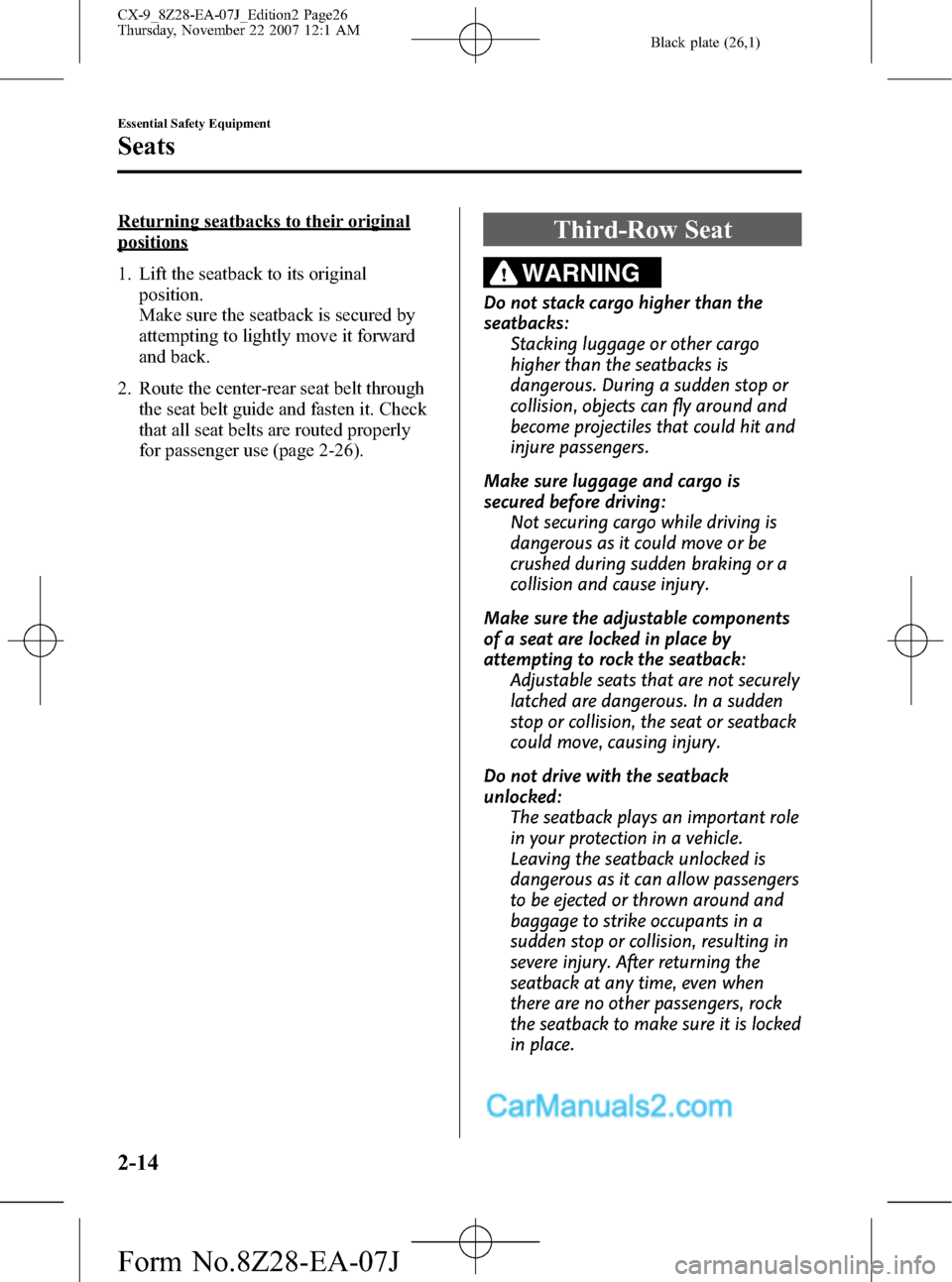
Black plate (26,1)
Returning seatbacks to their original
positions
1. Lift the seatback to its original
position.
Make sure the seatback is secured by
attempting to lightly move it forward
and back.
2. Route the center-rear seat belt through
the seat belt guide and fasten it. Check
that all seat belts are routed properly
for passenger use (page 2-26).Third-Row Seat
WARNING
Do not stack cargo higher than the
seatbacks:
Stacking luggage or other cargo
higher than the seatbacks is
dangerous. During a sudden stop or
collision, objects can fly around and
become projectiles that could hit and
injure passengers.
Make sure luggage and cargo is
secured before driving:
Not securing cargo while driving is
dangerous as it could move or be
crushed during sudden braking or a
collision and cause injury.
Make sure the adjustable components
of a seat are locked in place by
attempting to rock the seatback:
Adjustable seats that are not securely
latched are dangerous. In a sudden
stop or collision, the seat or seatback
could move, causing injury.
Do not drive with the seatback
unlocked:
The seatback plays an important role
in your protection in a vehicle.
Leaving the seatback unlocked is
dangerous as it can allow passengers
to be ejected or thrown around and
baggage to strike occupants in a
sudden stop or collision, resulting in
severe injury. After returning the
seatback at any time, even when
there are no other passengers, rock
the seatback to make sure it is locked
in place.
2-14
Essential Safety Equipment
Seats
CX-9_8Z28-EA-07J_Edition2 Page26
Thursday, November 22 2007 12:1 AM
Form No.8Z28-EA-07J
Page 27 of 506
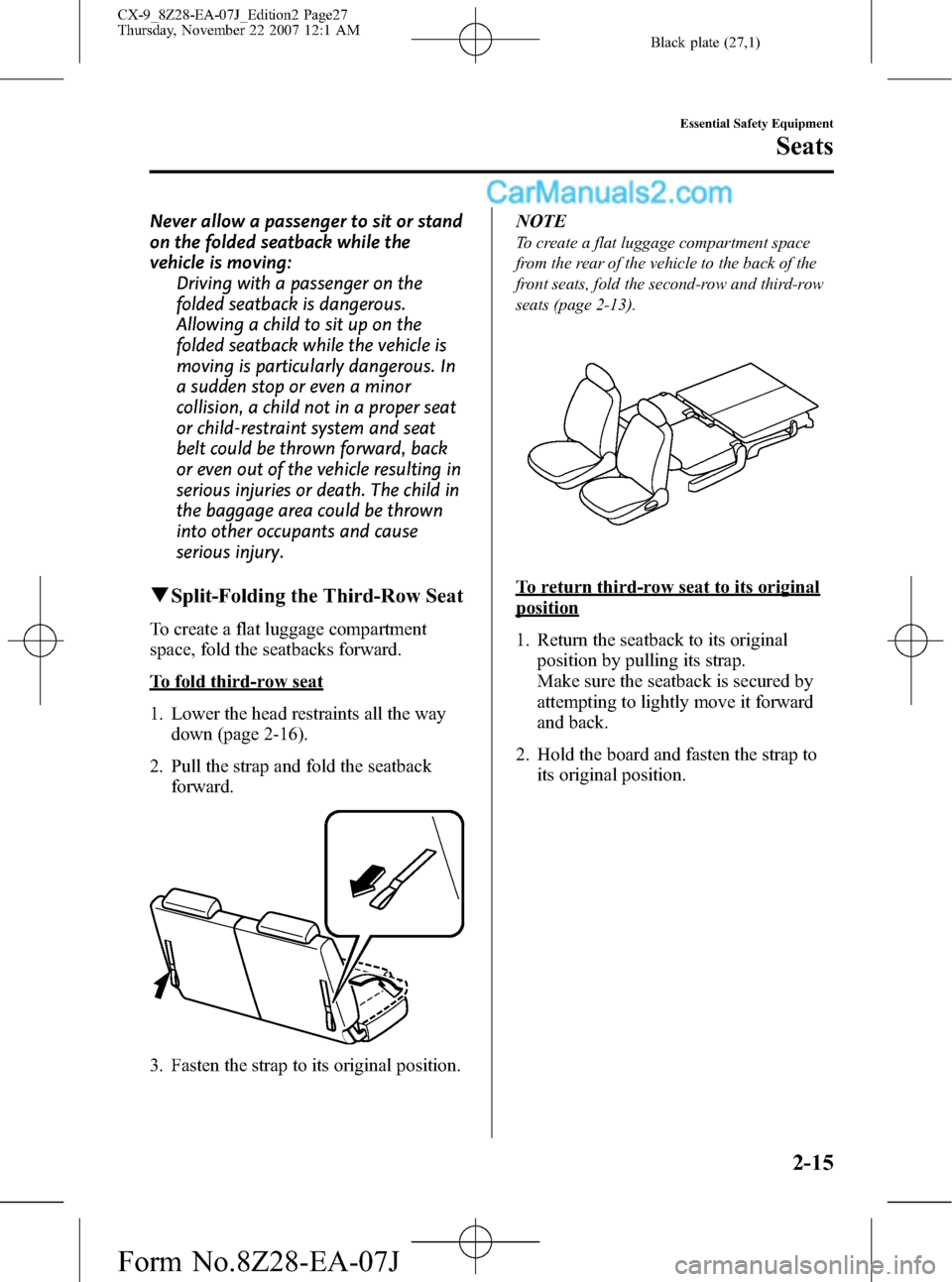
Black plate (27,1)
Never allow a passenger to sit or stand
on the folded seatback while the
vehicle is moving:
Driving with a passenger on the
folded seatback is dangerous.
Allowing a child to sit up on the
folded seatback while the vehicle is
moving is particularly dangerous. In
a sudden stop or even a minor
collision, a child not in a proper seat
or child-restraint system and seat
belt could be thrown forward, back
or even out of the vehicle resulting in
serious injuries or death. The child in
the baggage area could be thrown
into other occupants and cause
serious injury.
qSplit-Folding the Third-Row Seat
To create a flat luggage compartment
space, fold the seatbacks forward.
To fold third-row seat
1. Lower the head restraints all the way
down (page 2-16).
2. Pull the strap and fold the seatback
forward.
3. Fasten the strap to its original position.NOTE
To create a flat luggage compartment space
from the rear of the vehicle to the back of the
front seats, fold the second-row and third-row
seats (page 2-13).
To return third-row seat to its original
position
1. Return the seatback to its original
position by pulling its strap.
Make sure the seatback is secured by
attempting to lightly move it forward
and back.
2. Hold the board and fasten the strap to
its original position.
Essential Safety Equipment
Seats
2-15
CX-9_8Z28-EA-07J_Edition2 Page27
Thursday, November 22 2007 12:1 AM
Form No.8Z28-EA-07J
Page 28 of 506
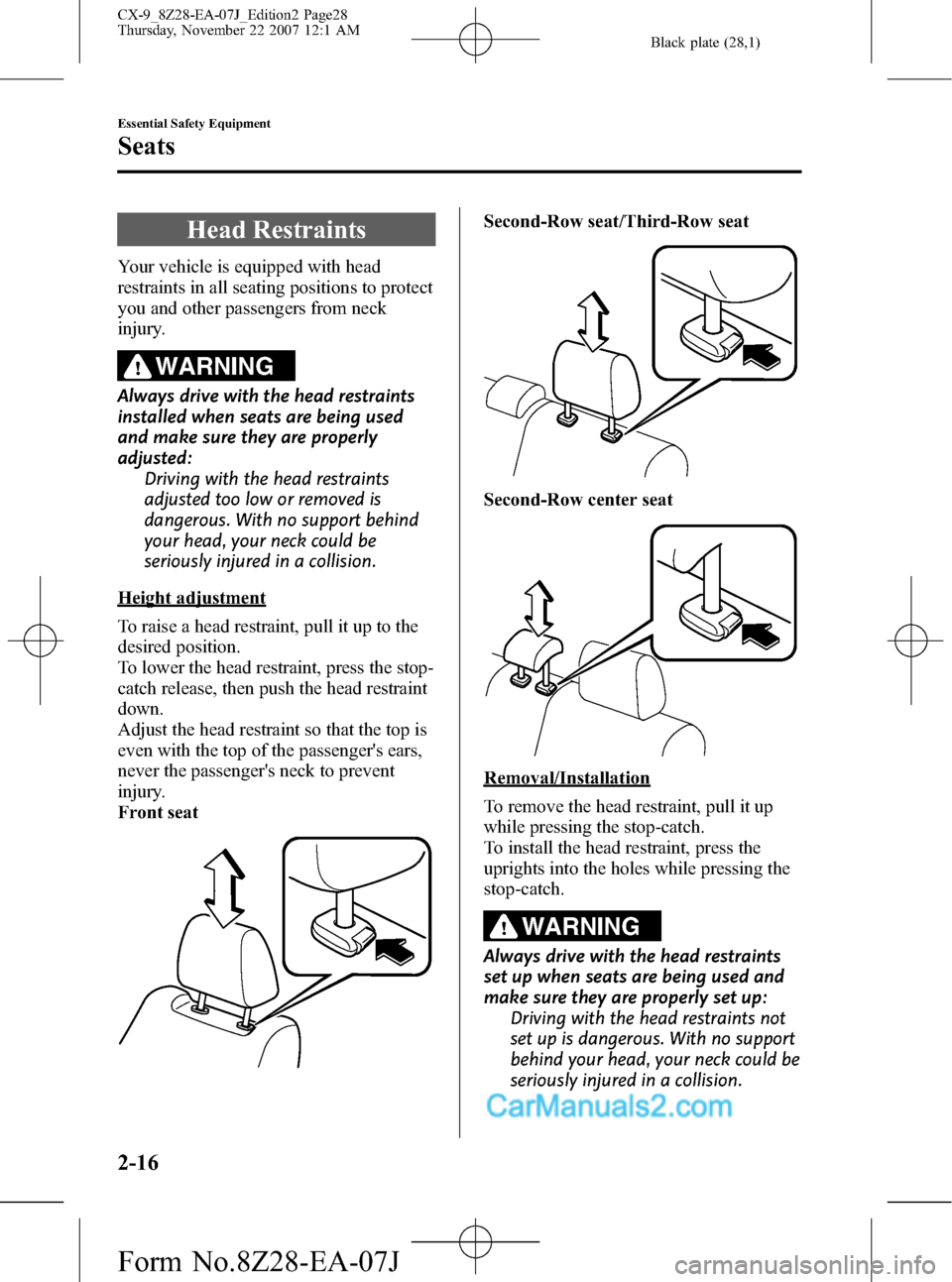
Black plate (28,1)
Head Restraints
Your vehicle is equipped with head
restraints in all seating positions to protect
you and other passengers from neck
injury.
WARNING
Always drive with the head restraints
installed when seats are being used
and make sure they are properly
adjusted:
Driving with the head restraints
adjusted too low or removed is
dangerous. With no support behind
your head, your neck could be
seriously injured in a collision.
Height adjustment
To raise a head restraint, pull it up to the
desired position.
To lower the head restraint, press the stop-
catch release, then push the head restraint
down.
Adjust the head restraint so that the top is
even with the top of the passenger's ears,
never the passenger's neck to prevent
injury.
Front seat
Second-Row seat/Third-Row seat
Second-Row center seat
Removal/Installation
To remove the head restraint, pull it up
while pressing the stop-catch.
To install the head restraint, press the
uprights into the holes while pressing the
stop-catch.
WARNING
Always drive with the head restraints
set up when seats are being used and
make sure they are properly set up:
Driving with the head restraints not
set up is dangerous. With no support
behind your head, your neck could be
seriously injured in a collision.
2-16
Essential Safety Equipment
Seats
CX-9_8Z28-EA-07J_Edition2 Page28
Thursday, November 22 2007 12:1 AM
Form No.8Z28-EA-07J
Page 29 of 506
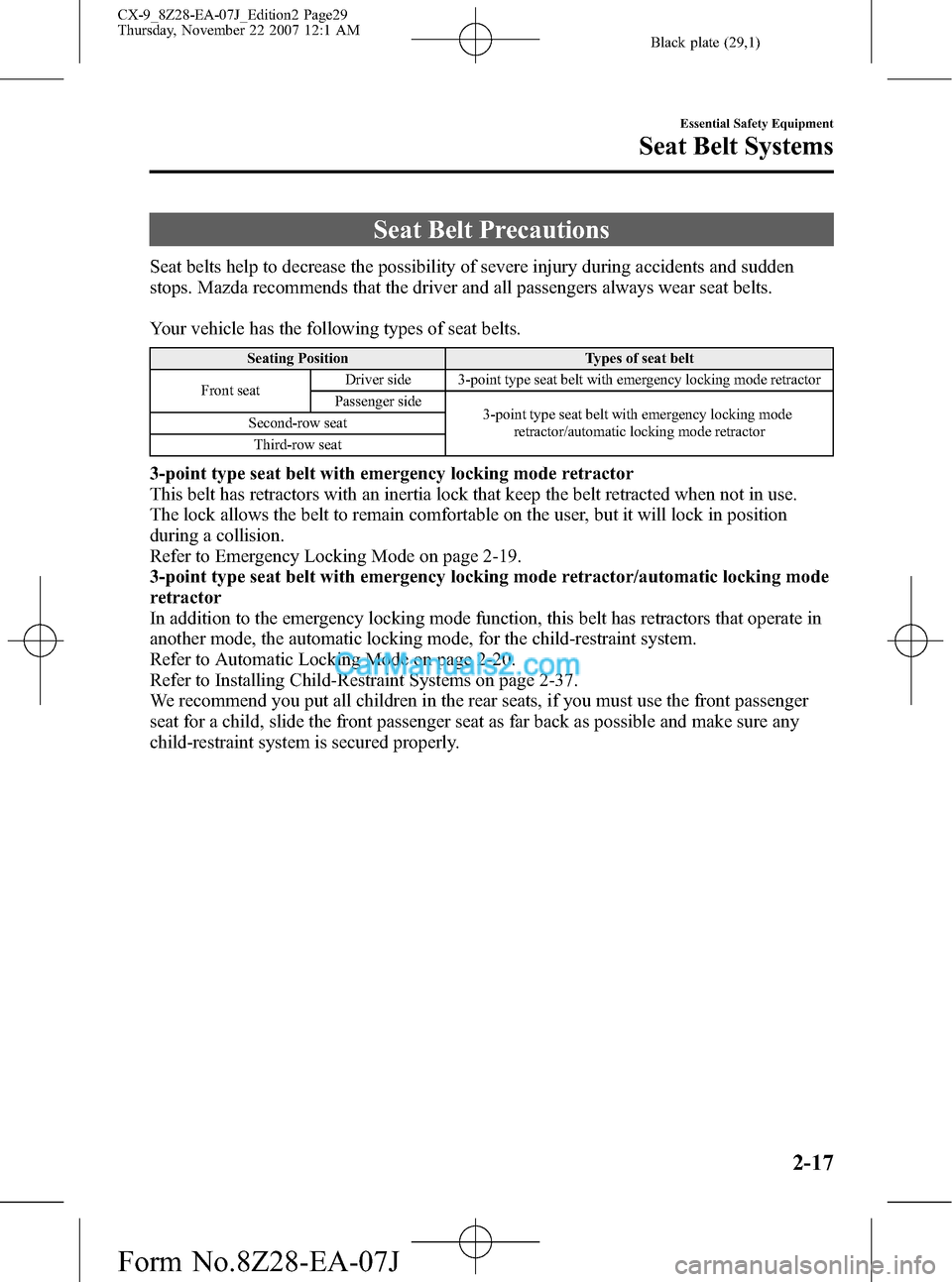
Black plate (29,1)
Seat Belt Precautions
Seat belts help to decrease the possibility of severe injury during accidents and sudden
stops. Mazda recommends that the driver and all passengers always wear seat belts.
Your vehicle has the following types of seat belts.
Seating Position Types of seat belt
Front seatDriver side 3-point type seat belt with emergency locking mode retractor
Passenger side
3-point type seat belt with emergency locking mode
retractor/automatic locking mode retractor Second-row seat
Third-row seat
3-point type seat belt with emergency locking mode retractor
This belt has retractors with an inertia lock that keep the belt retracted when not in use.
The lock allows the belt to remain comfortable on the user, but it will lock in position
during a collision.
Refer to Emergency Locking Mode on page 2-19.
3-point type seat belt with emergency locking mode retractor/automatic locking mode
retractor
In addition to the emergency locking mode function, this belt has retractors that operate in
another mode, the automatic locking mode, for the child-restraint system.
Refer to Automatic Locking Mode on page 2-20.
Refer to Installing Child-Restraint Systems on page 2-37.
We recommend you put all children in the rear seats, if you must use the front passenger
seat for a child, slide the front passenger seat as far back as possible and make sure any
child-restraint system is secured properly.
Essential Safety Equipment
Seat Belt Systems
2-17
CX-9_8Z28-EA-07J_Edition2 Page29
Thursday, November 22 2007 12:1 AM
Form No.8Z28-EA-07J
Page 30 of 506
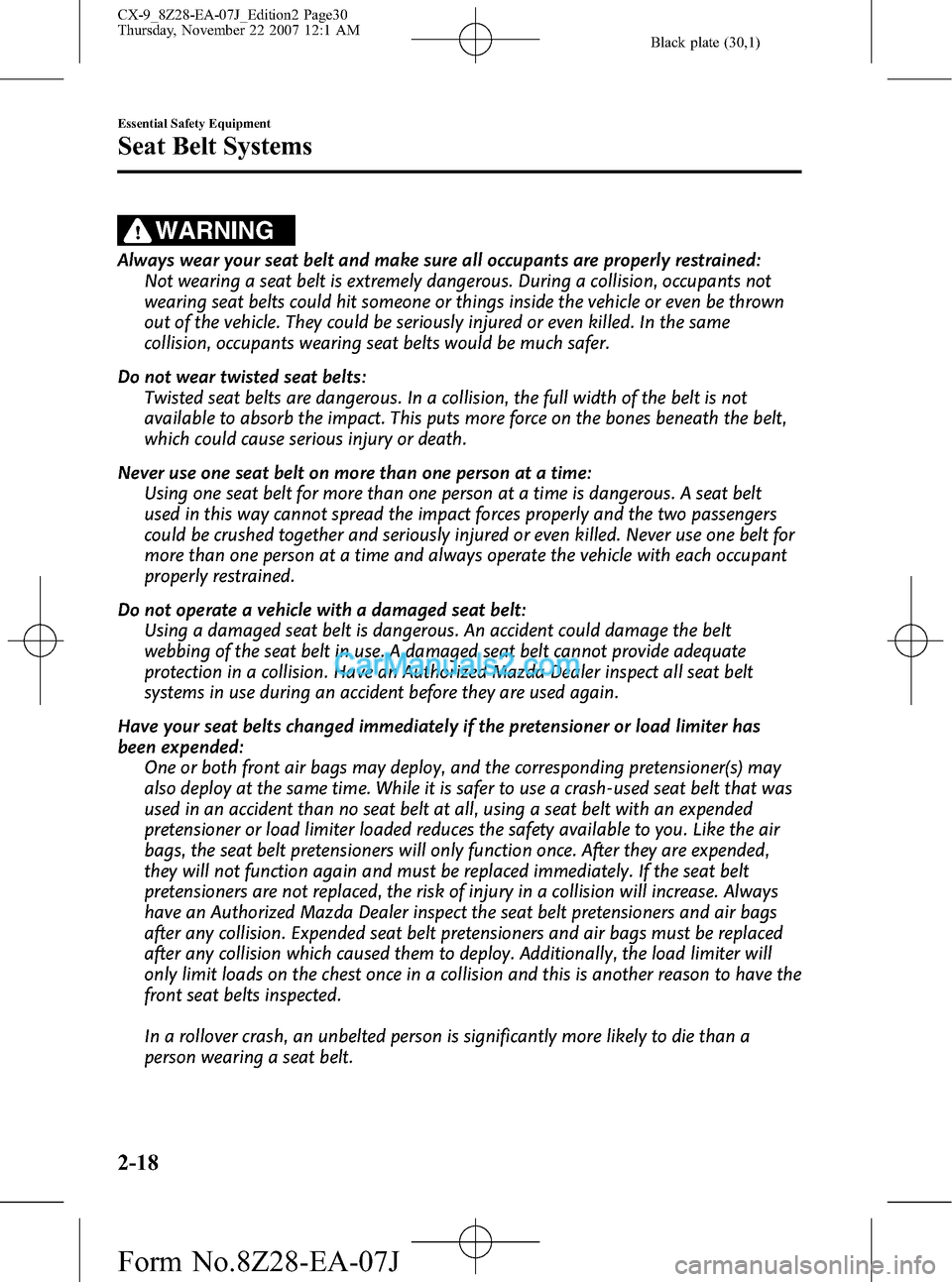
Black plate (30,1)
WARNING
Always wear your seat belt and make sure all occupants are properly restrained:
Not wearing a seat belt is extremely dangerous. During a collision, occupants not
wearing seat belts could hit someone or things inside the vehicle or even be thrown
out of the vehicle. They could be seriously injured or even killed. In the same
collision, occupants wearing seat belts would be much safer.
Do not wear twisted seat belts:
Twisted seat belts are dangerous. In a collision, the full width of the belt is not
available to absorb the impact. This puts more force on the bones beneath the belt,
which could cause serious injury or death.
Never use one seat belt on more than one person at a time:
Using one seat belt for more than one person at a time is dangerous. A seat belt
used in this way cannot spread the impact forces properly and the two passengers
could be crushed together and seriously injured or even killed. Never use one belt for
more than one person at a time and always operate the vehicle with each occupant
properly restrained.
Do not operate a vehicle with a damaged seat belt:
Using a damaged seat belt is dangerous. An accident could damage the belt
webbing of the seat belt in use. A damaged seat belt cannot provide adequate
protection in a collision. Have an Authorized Mazda Dealer inspect all seat belt
systems in use during an accident before they are used again.
Have your seat belts changed immediately if the pretensioner or load limiter has
been expended:
One or both front air bags may deploy, and the corresponding pretensioner(s) may
also deploy at the same time. While it is safer to use a crash-used seat belt that was
used in an accident than no seat belt at all, using a seat belt with an expended
pretensioner or load limiter loaded reduces the safety available to you. Like the air
bags, the seat belt pretensioners will only function once. After they are expended,
they will not function again and must be replaced immediately. If the seat belt
pretensioners are not replaced, the risk of injury in a collision will increase. Always
have an Authorized Mazda Dealer inspect the seat belt pretensioners and air bags
after any collision. Expended seat belt pretensioners and air bags must be replaced
after any collision which caused them to deploy. Additionally, the load limiter will
only limit loads on the chest once in a collision and this is another reason to have the
front seat belts inspected.
In a rollover crash, an unbelted person is significantly more likely to die than a
person wearing a seat belt.
2-18
Essential Safety Equipment
Seat Belt Systems
CX-9_8Z28-EA-07J_Edition2 Page30
Thursday, November 22 2007 12:1 AM
Form No.8Z28-EA-07J